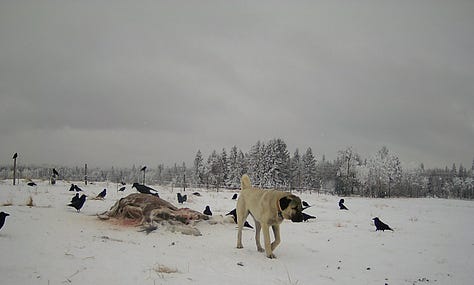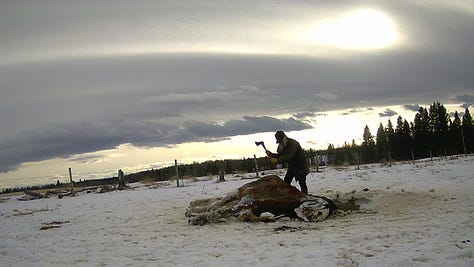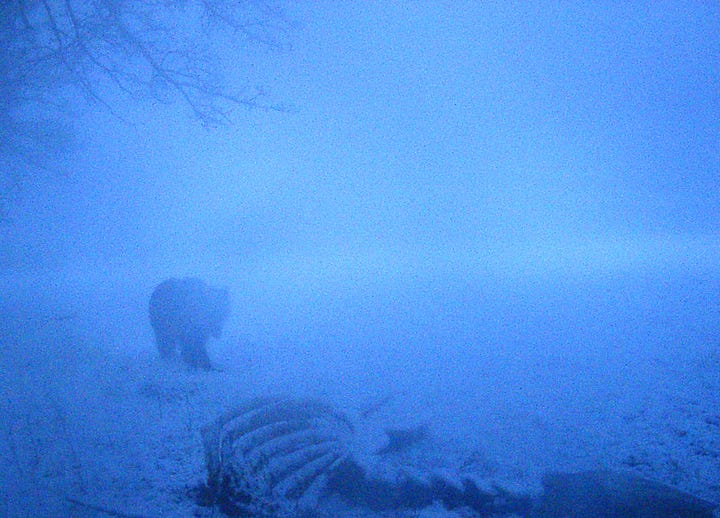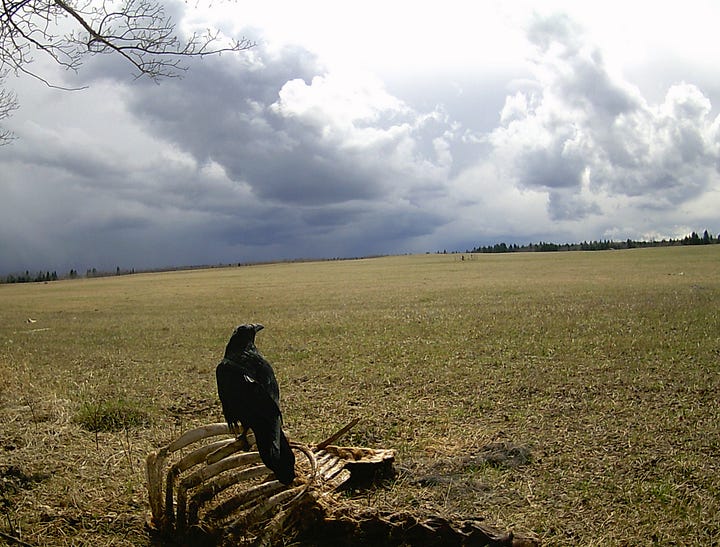In late February or early March of the year 2022 we lost one of our home-bred registered Clydesdale horses. This was the most recent horse to die on our place of natural causes, although I did shoot one last fall when it became patent that leaving it to a natural death would have been a cruelty. This on account of an irreversible lameness.
The death of a horse is always an event when it happens, but not a particularly rare one. Horses need no real excuse to drop dead, they are infamously good at it. Their internal design recommends it, even. As one writer put it, to paraphrase, the horse is an animal that got released from the factory before it went through proper trials.
I called the vet when we found her down subsequent to her not coming in for hay with her herd. The vet arrived in good time, but there was nothing she could do. Very often, a firm diagnosis is not even possible in such a case without an autopsy. Odds are some colic is involved, some torsion of the guts, but the textbook indications were not all there in this case. I was going to fetch the rifle to end the misery but only made it fifty feet when the vet called him back – she’s dying now. So we watched her go.
Not a happy event by any means, but very good news for scavengers. There would be no wastage here as occurs when a horse or other large animal is euthanized by lethal injection, the chemicals necessitating it be kept away from all other animals. Or at least, aboveground ones of any consequence to our favored version of things. Because she had died naturally, (and the same would be true of having her suffering ended by gunshot, natural or not, provided a copper-bullet was used) there was from one moment to the next an 1800 pound mountain of meat on the scene to be made ready for general consumption, or “natural disposal” as it is called in our county. Some windfall in a season of general scarcity. And so we were happy that if the horse had to die as it had, it chose that point in the season to do so. We were still a good month away from the spectre of grizzly bears. By the time they made their first appearance of the season, and they did, much of horse was apt to have been consumed by smaller creatures, including our own dogs. Not that we have anything against grizzlies consuming horses, our horses even, once they are dead. The problem lay in having such a hazardous animal laying claim to such a terrific bounty of meat that it would be likely to simply sleep overtop of and guard with its life. All fine and well miles back in the hills. Not so great at the edge of your hayfield a half mile from the house. At any rate, such a jealous claim was not likely to result once the carcass was down to bones and hide when the first bears came on the scene. While still likely a draw to the great bruins, it would not create a situation of menace to life and limb.
Most of the meat scavenged from large carcasses on this place is consumed by flocks of ravens, bald eagles, and our own dogs. Coyotes take some as do foxes, but not much, cos the livestock guardian dogs we run have them firmly in their crosshairs and hanging around here is treacherous for them. We like to haul a carcass, outside of bear-season, to a knoll in the pasture from where we can see it from the kitchen window. We open it at multiple locations with a large hunting knife for ease of access for the birds. This is the same function wolves provide for ravens, for instance. When the accessible side is done, we flip the carcass and open what couldn’t be reached on the other side – now frozen – with an axe. All of this we did, and recorded the results on a motion-triggered camera.
We found some of the resulting pictures compelling. Maybe you will too. Here are some highlights from the knoll, and from where we later moved the remains to at the back of the hayfield.









